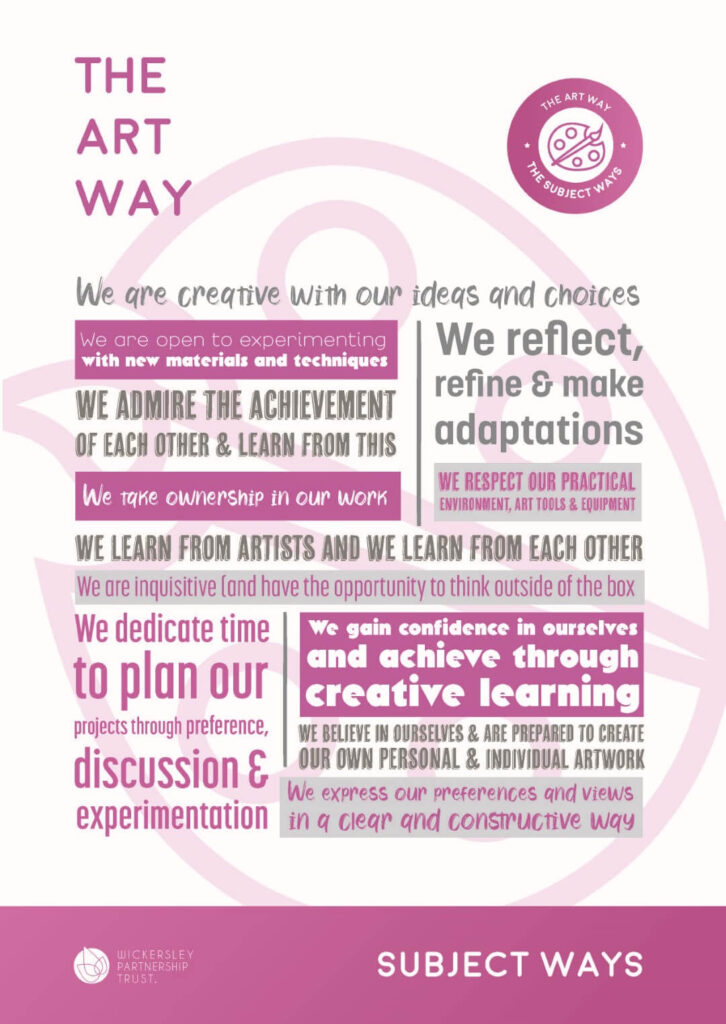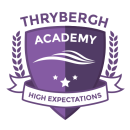Curriculum
Photography (GCSE)
Subject Staff
Mrs Cooper
The Art Way
Our subject has a ‘Subject Way’ at the heart of it. Our Subject Way is designed to help students become young subject specialists. The Subject Way has two main purposes:
Firstly, to teach students the vital skills they need to achieve their full potential and gain the very best grades they can. Secondly, to teach students how each subject relates to the wider world, incorporating the life skills they will learn.
It is our belief that knowing how what you learn links to the wider world, brings a subject to life and therefore improves overall understanding and engagement.

Curriculum Intent
At Wickersley Partnership Trust we understand that getting the curriculum right for each and every individual student is the single most important factor in ensuring progress, encouraging positive engagement and raising aspirations.
We want all students to leave able and qualified to play their full part in an ever-changing world through an ambitious, creative and innovative curriculum, which empowers students with the skills, knowledge and attributes to allow them to succeed in their next phase of education and their working life.
We aim to engender a love of learning, self-belief and aspiration through 4 key intentions:
- The removal of barriers to learning
- Developing skills for learning
- Fostering personal attributes (School Way)
- Enriching student experiences and broadening their horizons
Our curriculum is not driven by performance tables. It is our belief that a strong, broad, balanced curriculum, tailored to individual needs can remove there barriers to learning and allow all students to access the curriculum appropriate to them and will therefore meet their individual needs.
We believe in a strong foundation of core subjects including English, Maths and Science. All students who are identified with deficits in literacy and numeracy are given additional curriculum support. These core fundamental skills are essential in both accessing our broad curriculum offer and the next stage of life; be it education, employment or training.
INTENTION 1 – The removal of barriers to learning
We want all our students to go out into the world, and become successful, happy, fulfilled adults who will be good citizens and make a positive contribution to society. The acquisition of basic skills is either at the heart of achieving this or a barrier to learning and prevents students from fully flourishing. Four common barriers, if left unchallenged, will limit the progress, engagement and development of students who access our curriculum.
They are:
- Literacy
- Numeracy
- Oracy
- Vocabulary
We see these barriers as a high priority for the school. In order to prevent them from becoming a barrier for student development and progress we implement (and closely monitor) the following strategies:
LITERACY
Students annotate their work and comment on progress in the lesson on trackers.
- Comment in a sentence SPAG
- Sentence starters
- Keywords
- Prise (predict, read, identify, summarise and enquire)
- 5 point targeted reading
NUMERACY
Students estimation and measurement to plan and make visual art and design works and develop their capacity to recognise and use patterns and relationships, visualise 2D shapes and 3D objects and interpret maps, diagrams, data displays and chance events.
ORACY
Students are asked to read out annotations to ensure it is fully annotated. Peer assessment and then comment if students cannot read the writing. Say it in a sentence pick up on poor pronunciation and students asked to explain processes.
VOCABULARY
Students need to have a strong grasp of art vocabulary to discuss their own and others’ artwork and art processes. Vocabulary words, their meaning and usage, are such an important part of learning and communicating. The word wall in the classroom is used to promote a good understanding of the key vocabulary in Art and design.
INTENTION 2 – Developing skills for learning
Developing student knowledge and essential learning skills go hand in hand. Students need to remember with fluency in order to be fully established mini-subject specialists. We strive, at all times, for personal excellence by developing the 6 key skills for success:
- Recall
- Interpretation
- Creativity
- Analysis
- Evaluation
- Divergent thinking
To develop independent creative, artistic and passionate students that understand how Art is used in the world and how to develop confidence to use the skills in creating their own ideas. Equipping them with the knowledge and skills to experiment, invent and create their own works of art, craft and design. As pupils progress, they should be able to think critically and develop a more rigorous understanding of art and design. They should also know how art and design both reflect and shape our history, and contribute to the culture, creativity and wealth of our nation.
Art and Design try to ensure all students have a broad experience of creativity that explores the formal elements in all areas of drawing, painting, sculpture and photography. This develops into more focused study at Ks4 in Photography, Craft and Fine Art allowing for a range of creative specialism which become more diverse and focused. These will include modern, historical and cultural creativity which will be used to develop their understanding of Art helping them to become critical, independent artists able to create their own work.
All students will produce creative work, develop ideas and record experiences. They will:
- Gain skills in drawing, painting and sculpture and other art, craft and design skills
- Be able to evaluate and analyse others’ artwork using the language of art
- Learn about great artists, styles movements and understand the historical and cultural developments
INTENTION 3 – Fostering personal attributes
Our curriculum promotes the skills and attributes our children need in order to develop the independence, responsibility, accountability and resilience they need to have a happy and successful life. We refer to this crucial aspect of our curriculum intent as The Thrybergh Way and it is embedded in everything we do.
The School Way enables us to develop well-rounded individuals ready for the next stage. It is about embedding employability skills such as resilience, collaboration, communication, aspiration, responsibility, tolerance and respect in order for them to be an active participant in the local community and beyond.
The School Way is embedded in assemblies, form periods and our extra-curricular programme. It is the language that we speak and key aspects of the School Way are as follows:
- We are nice to people
- We say please and thank you
- We are equipped to learn
- We work hard
- We are prepared to make mistakes
- We listen to others
- We believe in ourselves
- We are proud of our achievements
- We take pride in our appearance
- We take responsibility for our actions
- We are ambitious
- We take risks
INTENTION 4 – Enriching student experiences and broadening their horizons
Our intent is that all students have a full understanding of how to develop themselves as well rounded citizens, maintain healthy relationships and understand how to keep themselves safe both online and in their day-to-day life. We want all students to know what options are open to them in the future and understand the routes they have in order to progress on their life journey.
Our curriculum will include:
- Artists and Cultural links
- Visits or a visiting artist
- Virtual galleries
- Looking at the greater awareness in the world / artwork
- After School Art clubs
- Links to employment e.g. ceramicist, printmaker
- Working with an artist in their own environment where appropriate
- Learn about Historical and Contemporary Artists
Curriculum
Students who opt to study GCSE Photography are divided between 60% portfolio (Component 1) and 40% Externally Set Assignment (Component 2).
During Y10 and Y11 students are given a selection of themes used as starting points to develop their ideas. Students are introduced to a variety of learning experiences that help them ‘Foster the love of Art,’ which encourage the development of skills through the use of appropriate media, processes, techniques and technologies.
Students learn how sources inspire the development of ideas. For example, drawing on the work and approaches of artists, craftspeople or designers from contemporary and/or historical contexts, periods, societies and cultures. Students develop skills and knowledge in figurative and non-figurative forms, image manipulation, close up, and imaginative interpretation of:
- Colour
- Line
- Form
- Tone
- Texture
- Shape
- Pattern
- Composition
- Scale
- Sequence
- Surface
- Contrast
Students are encouraged to be creative and independent in developing their own intentions.
Department Staff
J Wood
Director
- j.wood@thrybergh.com
Find out more
If you would like more information about our curriculum, please contact the school using the details on our contact page.
Our Subjects at KS4
CORE SUBJECTS
EBACC SUBJECTS
OPTION SUBJECTS


